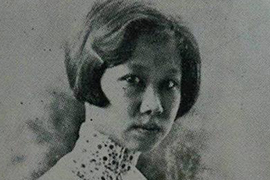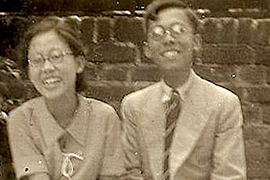
1913
INDUCTED
2014
CATEGORY
Health

THE HONOURED INDUCTEES TO THE SINGAPORE WOMEN’S HALL OF FAME
Maggie Lim
Maggie Lim, nee Tan, was, in 1930 the first schoolgirl in Singapore to win the prestigious Queen’s Scholarship. She is a direct descendant of philanthropist Tan Tock Seng who founded the hospital named after him in 1844. After qualifying as a doctor in London, she worked as a public health officer in Singapore and campaigned to raise awareness of birth control.
Studying at Raffles Girls’ School, Maggie earned a record six distinctions in her Senior Cambridge examinations. In 1929 she entered the prestigious and all-male Raffles Institution and she won the Queen’s Scholarship the following year – the first female in the award’s 45-year history and the second Singaporean to win it.
She attended the London School of Medicine for Women, then practised at the Royal Free Hospital, London’s only women’s training hospital. In 1939, she became a Member of the Royal College of Surgeons and a Licentiate of the Royal College of Physicians of London.
Returning to Singapore in 1940, she worked as a public health officer. During the Japanese occupation she was relocated to the Endau Settlement in Johor where she helped to maintain supply lines to the Malayan People’s Anti-Japanese Army and served as the Endau camp doctor. After the war, she resumed working for the British colonial administration.
Maggie specialised in maternity and child health and was consulted by 40 to 50 patients each day. She was concerned about the large number of children poorer women were having, sometimes as many as eight or more. These children often suffered from malnutrition. Through her efforts, the system of maternal and child health clinics was established throughout the island. In 1955, Singapore was awarded the Kettering Shield for having the best maternal and child health service in the Commonwealth.
In her work among the poor, Maggie frequently met women whose lives were endangered through unwanted pregnancies or who could not afford to have more children. She joined the newly founded Singapore Family Planning Association (SFPA) as Honorary Medical Officer in 1949, volunteering her time after work to advise patients. She was accused by some, as she reported at SFPA’s 1954 annual general meeting, of “corrupting the young and scheming to depopulate the earth”. She also encountered resistance from religious groups. The governing authorities were indifferent to her cause.
When the People’s Action Party came into power in 1959, there was finally support for her efforts. She led a successful government-sponsored birth control campaign, with an exhibition at Victoria Memorial Hall that then moved to community centres.
In 1963, Maggie became the head of the Ministry of Health’s Maternity and Child Welfare Department. She also joined the organising committee of International Planned Parenthood Federation’s regional council. In 1965, the Health Ministry established the Family Planning and Population Board and Maggie became its president. She also served on the board of the Midwives’ Council and the Medical Advisory Council until 1969 or 1970.
After retiring from the Maternal and Child Welfare Department, she had a second career as a professor of epidemiology and public health at the East West Center at the University of Hawaii. Her last years were spent in the university town of Claremont, California.

Maggie Lim
CATEGORY Health
Studying at Raffles Girls’ School, Maggie earned a record six distinctions in her Senior Cambridge examinations. In 1929 she entered the prestigious and all-male Raffles Institution and she won the Queen’s Scholarship the following year – the first female in the award’s 45-year history and the second Singaporean to win it.
She attended the London School of Medicine for Women, then practised at the Royal Free Hospital, London’s only women’s training hospital. In 1939, she became a Member of the Royal College of Surgeons and a Licentiate of the Royal College of Physicians of London.
Returning to Singapore in 1940, she worked as a public health officer. During the Japanese occupation she was relocated to the Endau Settlement in Johor where she helped to maintain supply lines to the Malayan People’s Anti-Japanese Army and served as the Endau camp doctor. After the war, she resumed working for the British colonial administration.
Maggie specialised in maternity and child health and was consulted by 40 to 50 patients each day. She was concerned about the large number of children poorer women were having, sometimes as many as eight or more. These children often suffered from malnutrition. Through her efforts, the system of maternal and child health clinics was established throughout the island. In 1955, Singapore was awarded the Kettering Shield for having the best maternal and child health service in the Commonwealth.
In her work among the poor, Maggie frequently met women whose lives were endangered through unwanted pregnancies or who could not afford to have more children. She joined the newly founded Singapore Family Planning Association (SFPA) as Honorary Medical Officer in 1949, volunteering her time after work to advise patients. She was accused by some, as she reported at SFPA’s 1954 annual general meeting, of “corrupting the young and scheming to depopulate the earth”. She also encountered resistance from religious groups. The governing authorities were indifferent to her cause.
When the People’s Action Party came into power in 1959, there was finally support for her efforts. She led a successful government-sponsored birth control campaign, with an exhibition at Victoria Memorial Hall that then moved to community centres.
In 1963, Maggie became the head of the Ministry of Health’s Maternity and Child Welfare Department. She also joined the organising committee of International Planned Parenthood Federation’s regional council. In 1965, the Health Ministry established the Family Planning and Population Board and Maggie became its president. She also served on the board of the Midwives’ Council and the Medical Advisory Council until 1969 or 1970.
After retiring from the Maternal and Child Welfare Department, she had a second career as a professor of epidemiology and public health at the East West Center at the University of Hawaii. Her last years were spent in the university town of Claremont, California.
“There is a crying need for scientific family-planning in this country.”
Sources:
- Maggie Tan Back From England – The Straits Times, 19 May 1940
- MISS MAGGIE TAN QUEEN’S SCHOLAR – The Straits Times, 24 January 1931
- “Crying Need For Family Planning” – The Straits Times, 23 February 1949
- Rafflesian Times
Profile last updated: 11th March 2021


